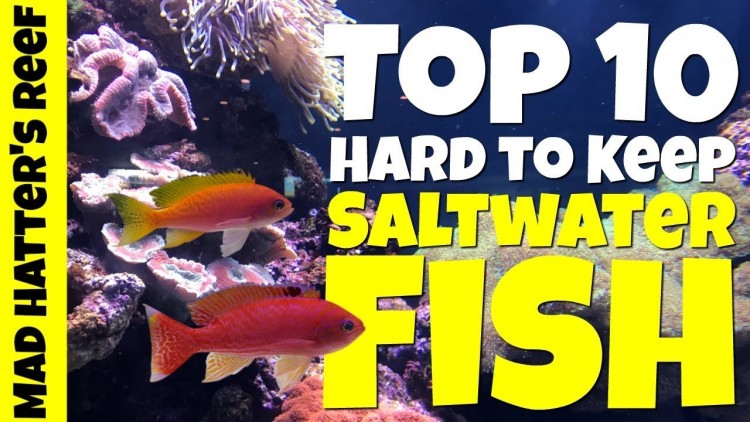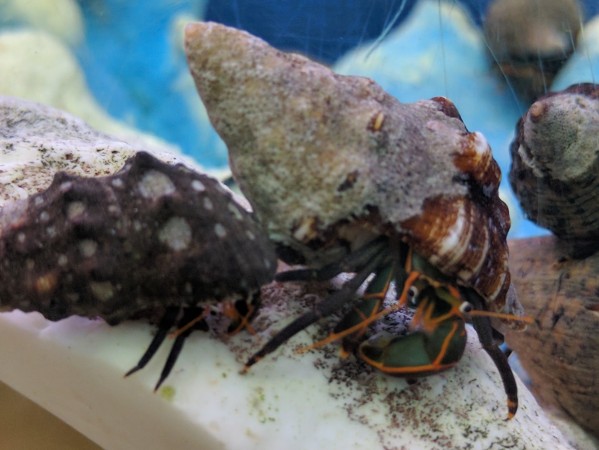Mad Hatters Top 10 Hard to Keep Saltwater Fish in a Reef Tank
- Aug 14, 2019
- Web Aggrigator
- 2474 0 0

This is Mad Hatter's top 10 fish that he feels like you should not put into your reef tank. The idea behind the video is to help educate people who are new to the aquarium hobby or have only been in the hobby for a short period and help those folks from potentially making a mistake by purchasing one of these animals and not having the knowledge or skill set to take care of it.
So here is Mad Hatter's top 10 list of fish that are suited for experts only.
10 - The Princess Anthias
While a peaceful fish and its coloration are amazing with its pinks and yellows and yellow dots, and colorful fish make it beautiful. It is considered reef safe, but like most Anthias its diet is what makes it difficult to keep. It requires a plankton sized food of 1.5 mm offered frequently throughout the day, and that is what makes it hard to keep. It also does not do well in a small quartine setup. It is a rare fish and its a fish that should be kept in small groups, so all of this makes it hard to keep in a reef aquarium especially someone who is new or less experienced in the hobby.
9 - The Blue Boxfish
While a peaceful temperament, an omnivore, and reef safe with caution so it is one those fish that you are never 100% sure what you are going to get and could start reef safe and as it gets older start picking at your coral. They grow up to 10" so the minimum tank size should be 180 gallons. The problem with the Blue Boxfish is not that it is hard to keep fish or that it requires special foods provided throughout the course of the day like the Anthias. The problem with this fish is that it can easily become stressed. If it gets stressed out, it produces a toxic substance on its skin, and it can absolutely decimate your tank. So if this is a species that you would like to keep you may want to consider keeping it alone in a species-specific setup.
8 - The Regal Angelfish
The Regal Angelfish can grow up to 10" and typically need a tank of 150 gallons or more. The reason this fish is so hard to keep is because it simply does not do well in captivity. It often refuses to eat, which eventually circums to nutrient deficiencies. So in the grand scheme of things, this is a fish that is better off left in the ocean and not attempted to be kept in a confined space like an aquarium.
7 - The Orangespotted Filefish
The Orangespotted filefish grows to 4-5" long and can be kept in a 55-gallon aquarium. The interesting part of this fish is it diet, now, this fish feed on the polyps of SPS corals that make this fish a very tricky dynamic in your reef tank because most of us who keep a reef tank like to keep SPS corals. If you are interested in keeping an Orangespotted filefish, you need to be able to plan on how to feed this fish but also have a sustainable food source for this fish. They get purity expensive if you are going to the local fish store and buying even the cheapest SPS fish to allow it to feed off of it polyps and constantly repeating that process. That aside this is probably one of the coolest looking filefish that I have seen and I think it would be interesting to have in a reef tank. I am just not willing to sacrifice my SPS corals for it.
6 - The Blue Ribbon Eel
The Blue Ribbon Eel can grow up to 4' long and can be kept in an aquarium as small as 75 gallons. Purity interesting dynamic there a 4' long Eel in a 75-gallon tank. The Blue Ribbon Eel comes in a variety of colors, juvenile are black until the mature and females are yellow males are blue so with that there are a lot of variations of this Eel while it is coloring throughout its life. Now as far as some ideas for keeping an eel it's better to have plenty of hiding places and if this is a fish that you plan on keeping its not a bad idea to work peaces of PVC below the rock so that it can completely hide itself. This is a very timid fish even though it is an eel it does prefer to live food and sometimes can reject all food. That is why it is typically listed as harder to keep fish.
5 - The Harlequin Sweetlips
I normally would not have rated this one a #5, but this is a fish that I have seen at PetCo available for sale. So I feel like it is important to talk about this fish and ultimately how un ideal this fish is in a saltwater tank. The Harlequin Sweetlips can grow upwards to 28" long and requires a tank of 500 gallons or better, and that is on the small size. The other problem with this fish is that they are phenomenal looking fish and their swimming pattern is absolutely amazing and make it even more attractive. Most people who see the fish instinctively want to buy it, and the survival rate of these fish are not that great. They are actually hard to get them to eat, and the ones that do eat will require a huge aquarium. So you are dealing with a fish that will get absolutely huge, and their ability to survive in a home aquarium is slim to none. It's a large fish that should be left in the ocean.
4 - The Mandarin Dragonet
This is hands down the hardest fish to keep that is frequently found in a fish store, and a lot of people see this fish and absolutely fall in love with it. The Mandarin Dragonets swinging pattern is unique, its personality is unique, and its colors are absolutely phenomenal. The problem with this fish is its feeding requirements. Most of the fish that are hard to keep comes down to its individual personality and their feeding requirements. If it's a docile fish that required live food to keep them alive, then it will be harder to keep. The Mandarin Dragonet needs a steady population of copepods, so even though its ideal for a tank size of 20-gallons, it does not mean that tank size will have a good population of copepods. So unless you have the ability to access copepods and constantly be introducing them to the tank. This is a saltwater fish that you will probably want to avoid.
3 - The Longfin Anthias
The Longfin Anthias is absolutely stunning; it grows to 2-1/2" and required a 55-gallon tank or bigger. This is a deepwater species of anthias so nine times out of ten when we have an issue with this fish, it is due to a swim bladder issue from being raised up from the depth too quickly. So if you are at the local fish store and you see this fish swimming oddly, it is probably best to avoid it. This fish requires ample feeding, so this fish should be fed five times a day, lots of hiding spaces, and does better in groups of 5 or more with one male and several females. The colors of this fish are mind-blowing.
2 - The Exquisite Butterflyfish
The Exquisite Butterflyfish grows to 5" and requires a tank of 125 gallons or more. This fish is absolutely beautiful the drawback is that it eats corals, that is what it needs for food. It eats LPS, SPS and it has a special desire for Acropora corals. It has been recorded that this fish has taken 90 bites out of an SPS coral in 20 min. 90 bites! That is insane, so if you have some deep pockets and you are not that really big on coral and think this fish is absolutely amazing then it probably the right fish for you.
1 - The Spikefin Goby
The Spikefin Goby grows to a maximum size of 1" that's right 1". It requires a tank of 2 gallons or more. In most cases, it is recommended to go larger, but for this is a fish, it will be better off in a smaller tank because they are prone to disappearing and never being seen again. So if it were me, I would probably put this guy in a small pico reef probably species-specific display tank and keeping the hiding places to a minimum. All that aside this is one of the most gorgeous gobies I have ever seen in this hobby, and that is why it is coming up as #1 in the list of hard to keep saltwater fish in a reef tank.






About author
The content found on this page was found and added by Tank Facts to make it easier to learn about new species and keeping all of the found content in one place. The brand and content is owned by the respected individuals and in no way considered Tank Fact